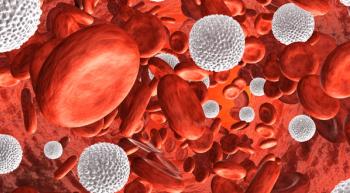
- March 2014
- Volume 8
- Issue 2
Many Miles Traveled, but a Journey Well Worth Taking
The FDA's approval of ibrutinib February 12 for the second-line treatment of patients with chronic lymphocytic leukemia (CLL) was exciting news indeed for thousands of patients with CLL who stand to benefit from the drug
John C. Byrd, MD
The FDA’s approval of ibrutinib February 12 for the second-line treatment of patients with chronic lymphocytic leukemia (CLL) was exciting news indeed for thousands of patients with CLL who stand to benefit from the drug. But for those patients whose clinical trial experience with the oral agent helped to spark its approval, the FDA decision marked just one more testament to how this treatment has transformed their lives.
The route to a virtually symptom-free life took Midge Lipkin, who has had CLL since 1985, and Donna Cann, first diagnosed in 2006, to Columbus, Ohio, where John C. Byrd, MD, and colleagues were testing ibrutinib in a clinical trial. When both patients’ disease had progressed under existing therapies, their respective oncologists had suggested that they might be good candidates for the trial underway at the Ohio State University Comprehensive Cancer Center—Arthur G. James Cancer Hospital and Richard J. Solove Research Institute.
For Cann, a resident of West Chester, Pennsylvania and a patient of Bernard Greenberg, MD, at Chester County Hospital, and for Lipkin, who had been under the care of Arnold S. Freedman, MD, at Dana-Farber Cancer Institute in Boston, the long journey to Ohio at first seemed daunting. But the hundreds of miles traveled proved well worth it, and both expressed gratitude to their home base oncologists for keeping an eye out for a clinical trial option which might work for them.
A Lump That Wouldn’t Go Away
Cann was diagnosed when her family doctor noticed a small lump on the side of her neck that wouldn’t go away. Early blood testing was normal, but as the months progressed, Cann said that the tests started showing her white blood cell count was rising quickly.
Donna and Harry Cann (center) with researchers Jennifer Woyack , MD, assistant professor of Medicine (left) and Erin Hertlein, PhD, (right) at the James Cancer Hospital and Solove Research Institute.
“At the time, I was working, and suddenly in the middle of the road I would fall asleep. And I was very lethargic, not feeling well, feeling as though I had the flu or something like that.”
It was Cann’s family doctor who suspected CLL, and he referred her to the hematology/oncology team at the nearby Chester County Hospital. With her numbers not that high at the time, the strategy was watchful waiting, a process that continued for 2 years, before she began to feel unwell again and was started on a chemotherapy regimen of rituximab and fludarabine every 3 weeks for 6 months.
Cann’s disease was in remission for about a year and a half, but in 2008, her oncologist said it was time to try something else. She was treated with bendamustine, but, she said, she acquired several infections and was hospitalized 5 times in 1 year.
Facing a grim prognosis of indefinite chemotherapy, Cann was, she said, “willing to try anything,” when Greenberg told her of a clinical trial he had been reading about and for which he thought she would be a good candidate.
Cann was one of 12 patients on Byrd’s trial when she began her ibrutinib therapy in June of 2011. She admits the first 4 months were “just rugged.” With her husband Harry by her side for the 8-and-a-half hour journey to Ohio, said Cann, “We had to go out every week for 2 to 3 days. We’d come home, and it would be time to turn around and go back.”
Cann responded quickly and well to ibrutinib. She had enlarged lymph nodes, and what she described as an enormous mass in her abdomen. She said Byrd predicted a strong response: “Within the first week, I think you’re going to see a difference,” he told Cann.
“And he was right,” she said, “because that week, it started to shrink.”
Cann remains in the trial, traveling to Ohio every 3 months now. She calls ibrutinib her “miracle drug. I feel wonderful. I’m 72. I don’t look it, I don’t act it, and I don’t feel it.”
Still Going Strong
When Lipkin was first diagnosed with CLL nearly 30 years ago, the approach, as with Cann, was “watch and wait,” she said. She then went through several rounds of chemotherapy, the first lasting a few years, but over time, the chemo regimens “worked less and less.” Chemotherapy she received while in Florida, where she now lives for about half the year, didn’t seem to work at all and was proving very toxic.
Midge and Al Lipkin
“I wasn’t sure if it was the wrong formula or what, but it just didn’t work. I was losing a lot of weight, and I was getting sicker, so I had to do something.”
When Lipkin reached out to Freedman, he urged her to meet with Byrd.
“I started traveling out to Ohio every week from Boston taking a family member with me, sometimes staying for 10 days, sometimes staying for a night or two, and then going back to Boston,” said Lipkin.
Nearly 3 years later, Lipkin said, she feels “fabulous.” Lipkin, who celebrated her 78th birthday last month, plays golf and continues her work as a certified educational planner with Schoolsearch, specializing in helping students and parents to find the right private school or college for each child.
She still travels to Columbus every 3 months, and has experienced no adverse events with daily ibrutinib. “The medicine has been tremendous.,” she said.
“Nothing restricts me. I feel great. I’ve had no side effects.”
Fast Track to Approval
These success stories offer hope for patients diagnosed with CLL. The American Cancer Society estimates that 15,720 new cases of CLL will be diagnosed this year, and approximately 4600 patients will die of the disease.
Ibrtinib’s journey from clinical trial to accelerated approval by the FDA took only 4 years, which, Byrd noted, is “very, very quick.” Behind this success story, he said, is, first, a commitment to basic science which identified the target Bruton’s tyrosine kinase (BTK) gene. Ibrutinib, which is marketed under the brand name Imbruvica, and is manufactured by Sunnyvale, California—based Pharmacyclics, Inc., is an irreversible smallmolcule inhibitor of BTK. The agent works by blocking B-cell activation and signaling, which prevents the growth of malignant B cells that overexpress BTK.
Byrd also cited a willingness among stakeholders to take risks: “To move the field forward in a big way, we have to do things differently, and we have to sometimes not be scared of things. Ibrutinib is one of the first irreversible inhibitors of kinase, and that is why it passed through a couple of companies because people were nervous about developing irreversible kinase inhibitors.”
Finally, ibrutinib’s story underscores the importance of collaboration. “It shows how quickly things can move when companies, academia, patients, and the FDA all work together around something very promising, ”Byrd said.
Byrd said he and other researchers first began to realize just how promising ibrutinib was about a year after a good number of CLL patients received the drug.
“It became obvious that the remissions in very refractory patients were quite durable. These people were not relapsing with other active drugs. Even in relapsed refractory patients, you might see responses, but people usually relapse within the first 6 to 12 months. With ibrutinib, that wasn’t happening, and people just continued doing better,” he explained.
“When I talk about this drug, I say it is like wine. With time, it is better.”
A ‘Patient-Friendly’ Drug
How well patients tolerate ibrutinib, said Byrd, is one of the most remarkable aspects of the therapy. “With ibrutinib, a very common thing that we hear patients say is that it makes them feel like they did before they had CLL. It gets rid of a lot of the disease-related symptoms, it doesn’t have a lot of side effects, and the side effects it has in most people are generally quite modest.”
Early on, he noted, patients on ibrutinib therapy may experience loose stools, heartburn, or rash, but these usually go away with time, and medications can be used for symptom relief. He said arthralgias are more common in younger patients, and while distressing, are very treatable with NSAIDs or acetaminophen. Patients can experience subcutaneous bruising, but it is generally of no clinical significance; the drug should not be given with warfarin, however, due to bleeding risk. Byrd said clinicians also should be aware that ibrutinib disrupts homing to tissues and, unlike cytotoxic chemotherapy, will increase peripheral lymphocytosis. Patients who have peripheral lymphocytosis actually do better, he said.
“One of the things that doctors and nurses treating patients need to recognize is the drug can cause peripheral lymphocytosis, as the disease is responding elsewhere. It is important to tell the patient that that’s to be expected with this class of drugs, and there is no clinical concern.”
Byrd said that his team will continue to follow the clinical trial participants over the long term to see if any new adverse events emerge.
Remaining in the trial suits patients like Lipkin and Cann just fine. Both wholeheartedly agree that Byrd puts patients first, and is always willing to spend whatever time it takes to put them at ease. Said Lipkin: “Dr. Byrd is a powerhouse. He’s so good to everybody, and there’s never a time he can’t answer a question. He’s always available.”
Looking Ahead
Byrd sees applications for ibrutinib beyond CLL. “I think the most exciting potential for this drug is its ability to modulate the immune system outside of targeting BTK. It targets alternative kinases, like ITK, which are important to T-cells which are immune suppressive. Ibrutinib has the potential to enhance immunomodulatory therapies such as PD-1 and CTLA-4 antibodies. As part of this, one could see ibrutinib extending to solid tumors when it is given in conjunction with other immune therapies.”
“I think we are blessed with a transformative drug, and now we need to know where we apply it.”
Articles in this issue
over 11 years ago
Role of Corticosteroids Unclear for Men With mCRPCover 11 years ago
One in Five Cancer Trials Ends Too Earlyover 11 years ago
Follow-up Confirms Safety of Radium-223 in mCRPCover 11 years ago
Behavioral Approaches May Help Insomniaover 11 years ago
E-Cigarettes: Are They Safe? Are They Effective?over 11 years ago
The Role of Advanced Practice Nursing in Palliative CareNewsletter
Knowledge is power. Don’t miss the most recent breakthroughs in cancer care.
















































































